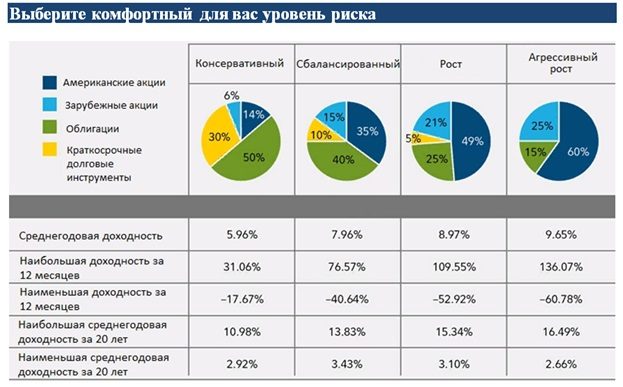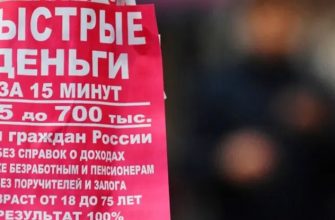An individual investment account (IIA) is a brokerage account through which one can invest in the securities market. But, unlike a regular brokerage account, IIS gives the right to receive tax benefits / deductions from the state.
- What is an individual investment account for, what are its main pros and cons and how it works
- Types of tax deductions
- Tax deduction type A
- Tax deduction type B
- How can you open an individual investment account – what is needed and how much IIS should be opened
- How to close IIS
- IIS investment strategy
- How to proceed for beginners
- For experienced investors
- Trust management of IIS
What is an individual investment account for, what are its main pros and cons and how it works
There can be only one brokerage account with tax incentives. The law allows a citizen to have 2 IIS at the same time for no more than a month. When opening an account with one broker and not yet closed an account with another
broker . At the same time, the law does not provide for a limitation on the number of ordinary (non-investment) brokerage accounts. A regular brokerage account cannot be made an investment account. IIS must be opened additionally.
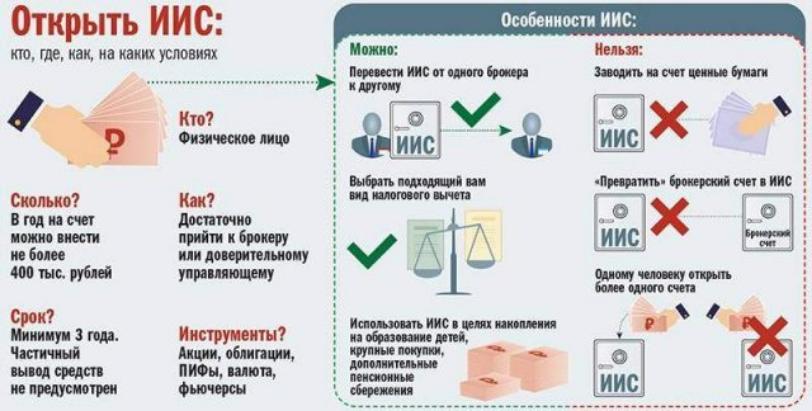
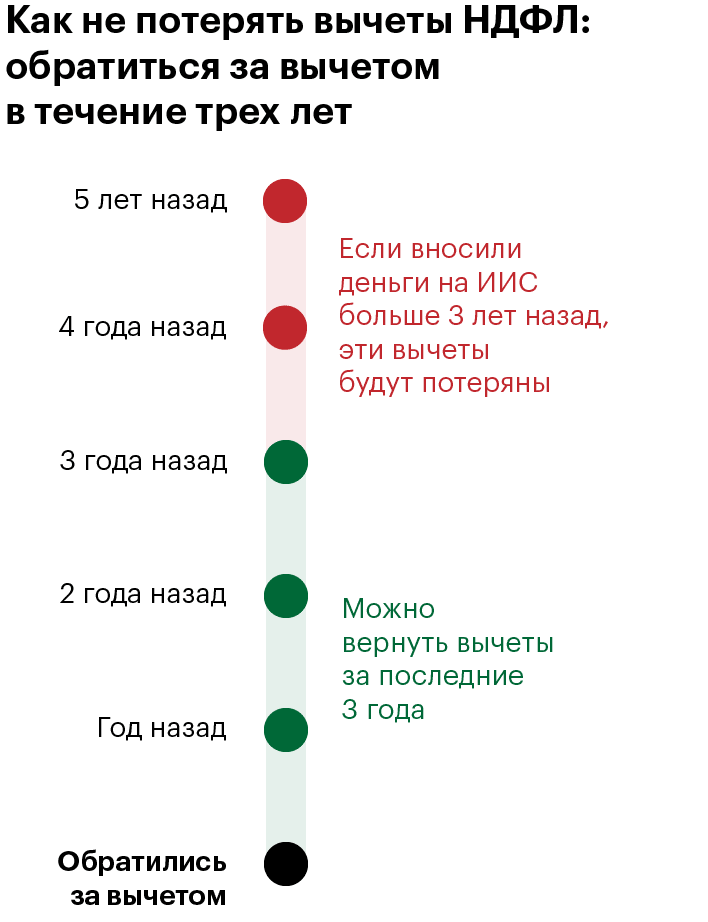
It is impossible to withdraw part of the funds from the IIS. Any withdrawal of funds leads to automatic closure of the account. But it will not be possible to automatically close the IIS, rather the broker will simply block the withdrawal operations.
Not every employee can close IIS even if there are no assets on the individual brokerage account. Also:
- Only rubles can be deposited into the IIS account.
- An individual investment account can buy any instruments that are traded on the Moscow Exchange , including ETFs and derivatives, futures and options.
- IIS can be traded on the Moscow and St. Petersburg stock exchanges.
- The purchase of foreign shares (except for shares traded on the St. Petersburg Stock Exchange) is not permitted. Customers who wish to trade in the US, China or India market directly will not be able to receive tax deductions for such transactions.
- Some brokers (for example, VTB) allow withdrawing dividends and coupons of bonds to a bank account. If you return these funds to the brokerage account, it will be considered as a replenishment and you can get a tax deduction from this money. If coupons and dividends are credited to the brokerage account, it is not considered a deposit.
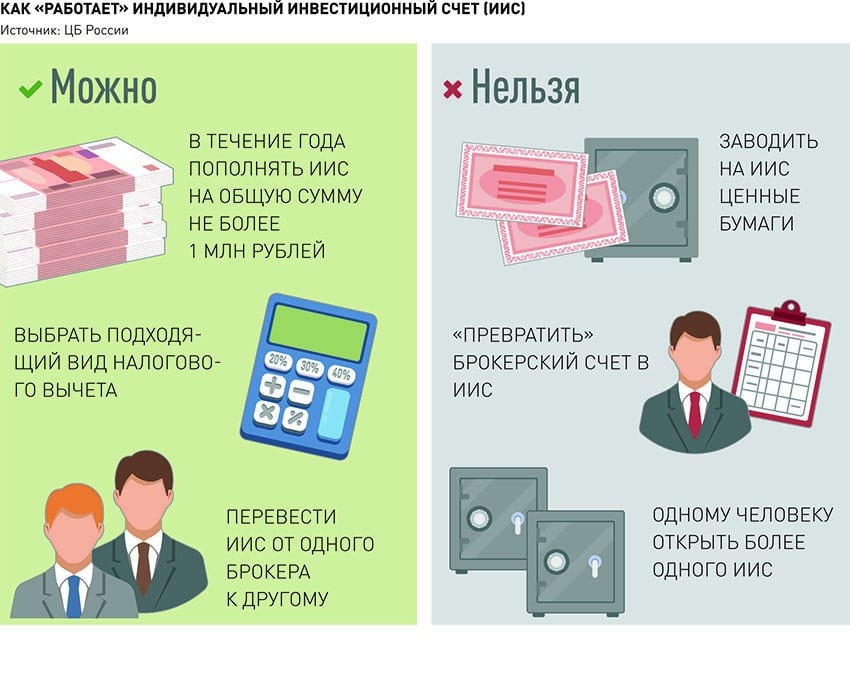
- You can specifically buy stocks 1-2 days before the dividend payment, or federal bonds a few days before the coupon payment. Daredevils even buy them with financial leverage. To increase coupon payments. Thus, you can withdraw to a bank account up to 50% of the IIS account per year. Everything should be calculated so as not to incur losses. After all, after the dividend cutoff, the shares fall by about the size of the dividends. For the provision of leverage, the broker charges a fee that will not pay off if you hold a losing position for a long time.
- The law does not establish the maximum term of the IIA. You can continue to use it after three years, receiving deductions every year. In this case, you can close it at any time.
- Funds in a brokerage account (any) are not insured by the DIA. Investments involve the risk of losing your investment.
- Assets (stocks and bonds) are not held by a broker, but in a depository and will remain yours even if the broker goes bankrupt. Funds in a brokerage account do not have this protection.
What is IIS – understandable and accessible about an individual investment account: https://youtu.be/zKkgnJLil1s
Types of tax deductions
On IIS, you can get two types of tax deductions.
Tax deduction type A
Refund 13% of the amount deposited to the brokerage account, but not more than 52 thousand per year. To draw up a deduction, it is required to submit to the tax authority (filled out electronically through the personal account of the Federal Tax Service):
- 2-ndfl certificate for the tax period;
- an agreement with a brokerage company for maintaining an account;
- confirmation of replenishment of an individual brokerage account – a receipt or payment order from the bank;
- 3-ndfl (to be filled in in the personal account of the Federal Tax Service).
The documents must be submitted within a maximum of three years from the year for which the tax credit is required. The tax office will transfer funds to the details specified in the application within a maximum of 4 months – 3 months for verification and 1 month for transferring funds. You can get a tax deduction even if there is no official salary – 2-NDFL can be obtained, for example, with positive trading on a regular brokerage account. Thus, you can reduce the taxes paid without restrictions on the withdrawal of part of the funds from the brokerage account. Also, through the IIS tax deduction, you can return the tax paid on the sale of real estate, on interest on deposits or tax paid for royalties. Self-employed (tax is paid at a rate of 4 or 6%) will not be able to return taxes through IIS.
Tax deduction type B
A citizen is exempt from paying taxes on all income for the period of the account. With the exception of dividends, tax is deducted from them regardless of the type of account. You will also have to pay tax on the sale of precious metals and currency. A citizen can decide which type of tax benefit to choose up to the date of closing the account. But having already received tax deductions, it will no longer be possible to change the type of tax benefit. To change the type of deduction, it is required to open a new IIS after a three-year period. The new account will again be able to choose a deduction. The law does not provide for a limitation on the number of newly opened accounts during the life of a citizen.
A draft law is being prepared on the third type of tax deduction – the term of the account is from 10 years, with replenishments of more than 1 million per year. Officials assume that in this way citizens will save up for real estate.
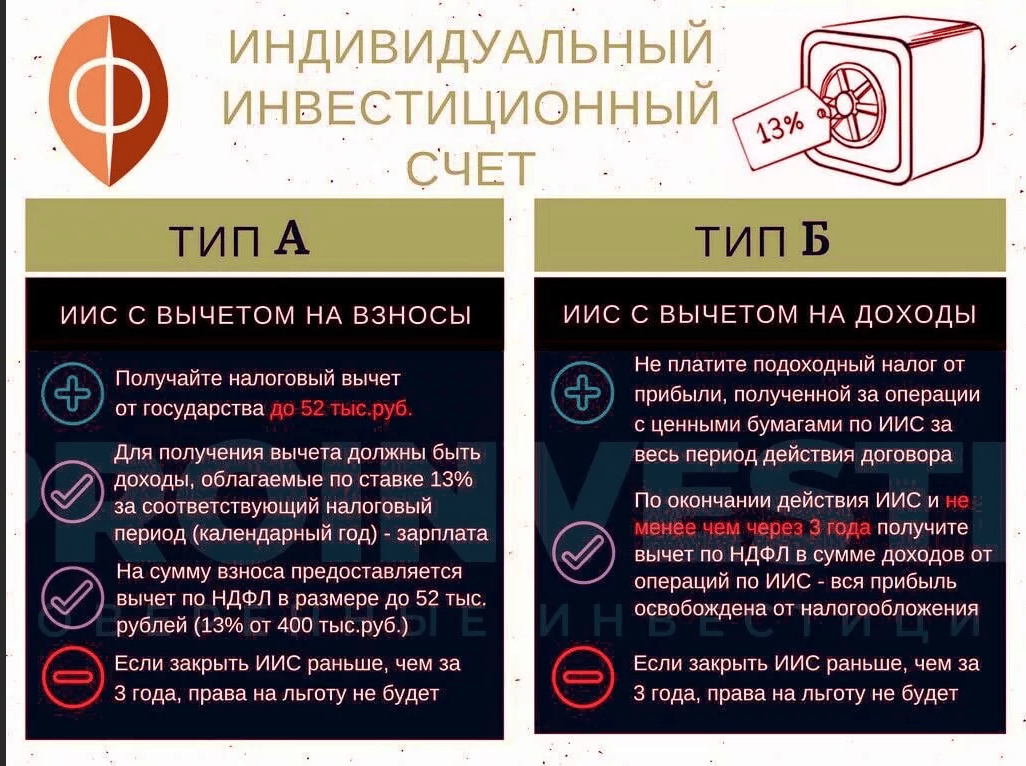
How can you open an individual investment account – what is needed and how much IIS should be opened
To open an individual investment account, only a passport is required. In some cases, they may ask for SNILS or TIN. Most brokers provide this service remotely. Changing a broker after opening an IIS is a rather costly procedure, therefore, you should approach the choice of a broker responsibly – study the rates on the broker’s website, go through the forums, read customer reviews. IIS Investments Opening https://open-broker.ru/invest/:
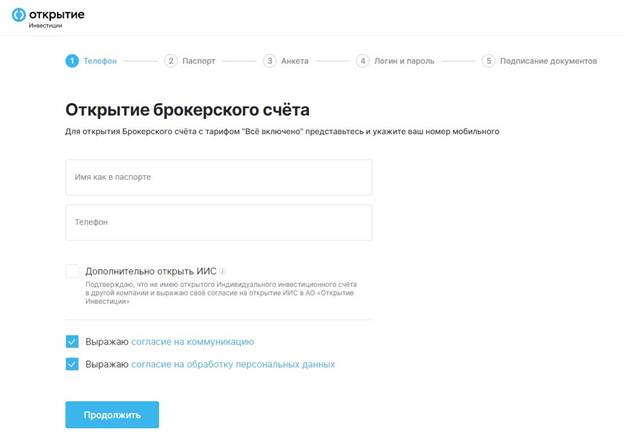


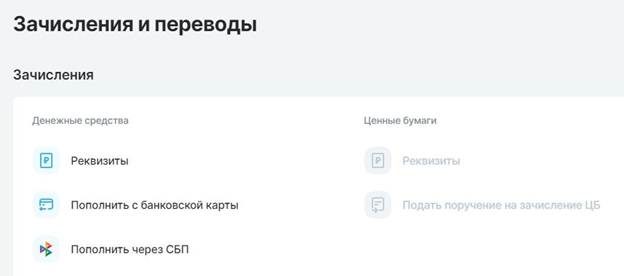
How to close IIS
The closure of the IIS is carried out only in the department. It is worth noting that there should be no assets there to close an account – only cash. It is possible to close IIS with assets and transfer them to another IIS or a regular brokerage account. Not all brokers inform their clients about this opportunity. Closing an IIA with assets is a troublesome procedure and you will have to pay a commission of about 200-400 rubles for the transfer of each share or bond. When transferring assets from one broker to another, personal income tax is not paid, the citizen retains the right to deductions. The three-year shareholding benefit cannot be used on the IIA. To receive such a benefit, it is necessary to transfer shares to a brokerage account (if the broker carries out such operations). Thus, you can immediately get 2 types of deduction – for replenishment through a tax deduction of type 1 and for income,if the trading strategy involves long-term holding of positions.
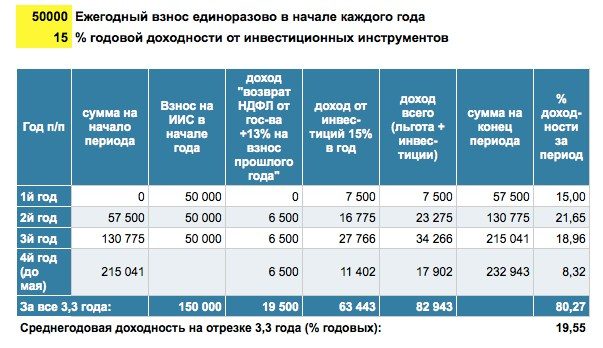
IIS investment strategy
How to proceed for beginners
If you are new to the financial markets and have a formal job with an income of more than 400,000 per year, the most winning strategy is to top up 400,000 per year (lump sum or monthly), buy federal loan bonds with these funds and receive a tax deduction of Type A. In case of self-management of IIS, the installation of special software on a computer or phone is required to carry out trading operations. Up to 5 applications per month can be made free of charge through the operator by phone. Such a simple strategy with practically no risks brings about 15% per annum.
For experienced investors
If you are an experienced investor and have a strategy that brings in more than 13% per annum, it is more profitable to stick to it on the IIS and, after the expiration of the established period, choose a type B tax benefit. An IIS calculator that offers to calculate the return on investment online can only give an approximate idea of the profitability. Even if the official salary allows you to get the maximum tax deduction, it is impossible to predict how much you will be able to pay on a monthly basis.
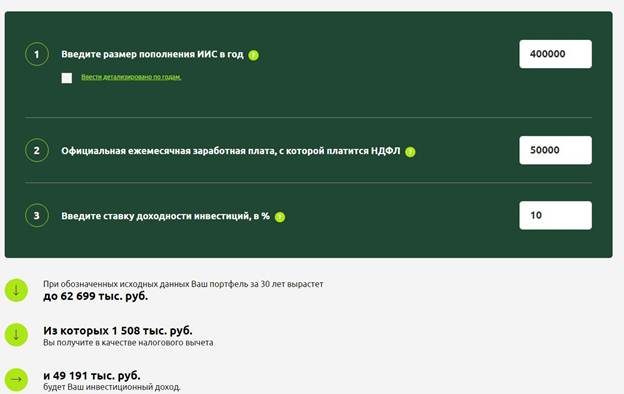
There were cases when citizens did not trade on the IIS, using only to obtain a tax deduction. In this case, the tax office may refuse to issue a tax deduction due to the fictitious account. To avoid the risks of such a situation, you should buy federal loan bonds with a short maturity.
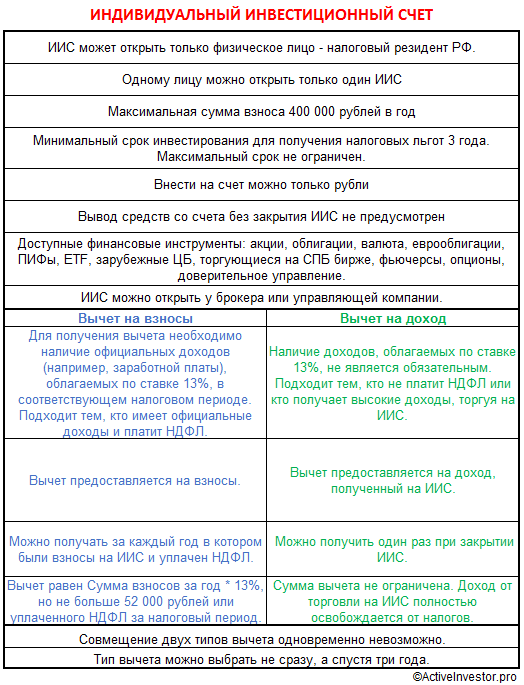
Trust management of IIS
If you do not know how to trade and are ready to take risks to get a higher income, you can use the service of a broker for trust management of IIS. Many large brokers offer out-of-the-box investment solutions with moderate to high risk. In this case, income guarantees are not given, there may even be a loss. But the annual commission for the management of IIS will still have to be paid. It is necessary to check that the trust management agreement contains a clause on maximum losses, upon reaching which trading stops. Otherwise, instead of profit, you can lose all the money. When self-managing IIS, the client is not limited in the amount of replenishment, you can transfer funds at any time. He can even transfer 100 rubles to start investing. One has only to understand that the less the investment amount,the less the ruble profit will be received. When investing through the trust management of the IIS, it is required to replenish the account immediately upon signing the agreement. The minimum top-up amount is 90-100 thousand rubles. Often, a broker offers ready-made investment products for working on IIS with different levels of risk:
- Low risk level – money is invested in an exchange-traded fund of shares. The declared yield is 0.9-15%. It is expected that even in the most negative scenario, losses will be covered by a tax deduction.
- Medium or low risk – money is invested in stocks / federal bonds / corporate bonds in the proportion of 10% / 30% / 60%. The historical profitability of the strategy is 52% per annum since 2017. During the investment period (the broker recommends investing for at least 3 years), the client may receive negative returns. There is no loss threshold.
- High level of risk – money is invested in the top 10 shares of the Russian Federation with certain proportions. Historical profitability of the strategy since 2017 is 72%. There is no loss threshold.
